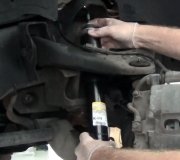Finally, someone understands how important this is. Over-tightening lug nuts will peel the threads. It can be impossible to remove a nut with damaged threads. Unfortunately it is the person trying to work on the car now who gets the blame, but it was caused by the previous person who over-tightened them. The nuts need to be tight enough so the friction surfaces hold them from working loose. They must not be so tight that a small person cannot change a flat tire. Using a torque wrench also insures all the nuts are tightened an equal amount. Equal clamping forces reduces the chances of a brake rotor or drum warping.
The torque spec for your lug nuts is listed as "85 to 105 foot pounds''. That is not very helpful, and it implies they do not all have to be the same on one wheel. A real common spec for many cars is 95 foot pounds for steel wheels, and 85 foot pounds for aluminum wheels. That is what I use for all of my cars and minivans.
Be careful too when using grease on the studs. Absolutely, under no circumstances, ever use anti-seize compound of the studs. If a boss or supervisor ever insisted that be done, I would find a different place to work. If an employee is caught doing that, he might get one verbal warning, but for the second offense he would be invited to find a job somewhere else. It is almost guaranteed the nuts will work loose. Once they do, the wobbling wheel will tear up the mating surfaces of the nut and the wheel. After that, the nuts will never remain tight. The only solution is to replace the wheel and the nuts.
Do not use any type of grease on anodized studs. Those have a bluish, yellowish, or silver color, and are found mainly on import vehicles. That coating is a lubricant. Many greases will dissolve that protective coating.
For non-coated steel studs, you can use a very thin film of grease or oil on the threads, but you have to be extremely careful to not get any lubricant on the mating surfaces between the nuts and the wheel. Those surfaces are what holds the nuts tight. It used to be a common sight to see someone plant a huge gob of grease on a stud, then run the nuts on with air tools. The grease wash up onto the front of the nuts, then centrifugal force spun it out onto the friction surfaces where it did its dastardly deed. If you are going to use anything, wipe on just enough grease to leave a fingerprint, then run the nuts on by hand. Follow that up with the torque wrench.
For the rest of what you listed, it's true we usually go by common sense, but our experience includes learning by trial and error, especially with aluminum housings. The lower rear shock absorber bolt is listed at 66 foot pounds, which seems rather high. The upper bolts call for 30 foot pounds. If those are the design I am familiar with from years ago, that also seems quite high. Use common sense (tighten the nut until the bolt snaps, then go ten foot pounds less!).
For the front shock absorbers, the upper nut calls for 30 foot pounds, and the lower calls for 10 - 13 foot pounds.
The bolts for the differential housing call for 33 foot pounds. That seems much too high, so use common sense. Most axles use a silicone sealant instead of a paper or fiber gasket. The main purpose of the bolts is to hold the cover in place until that sealant sets up and cures. It does not take anywhere near 33 foot pounds to do that. If I had to guess, I would say that was supposed to be listed under "inch pounds", not foot pounds. Even the fill plug is only listed at 22 foot pounds, and it is three times the diameter.
The transmission pan bolts call for 9 - 11 foot pounds. I would call that ten foot pounds. Those will be going into an aluminum housing, and it's easy to tear the threads out. If that happens, there are "Heli-Coil" repair kits available at any auto parts store. They are pretty easy to use, and I can describe it if you are not sure what to do. You can also do a makeshift repair by sticking a piece of 12 or 14 gauge solid copper wire in the hole, then running the bolt in alongside it. Here too, the goal is to hold the pan snug until the sealant cures. Once that occurs, usually within a few hours, you can remove all the bolts and nothing will happen. You will have to pry and grunt to get the pan off, so those bolts really are not doing much.
Related to those pans and covers, be sure both surfaces are totally cleaned of any fluid residue. If there is a film or an area where dripping fluid is running off, the sealant may not bond and seal in that area. I am very familiar with Chrysler's silicone sealants, but other manufacturers have similar products. Their black stuff stays more flexible and is easier to pry parts apart, but it will not seal through an oily residue. You will have a leak in that area. Their gray stuff will bond through a film of oil, but it sets up less-flexible, and is harder to pull things apart later. It takes more work to scrape the sealant off next time too.
Sunday, February 26th, 2017 AT 6:34 PM


